Sports
How college baseball learned to stop worrying and lean into the long ball
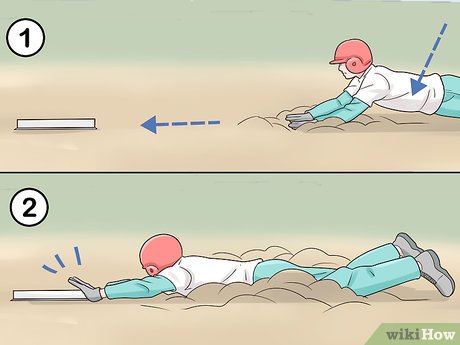

College baseball has spent much of the last three decades bouncing between offensive extremes, from the gorilla ball to the dead ball and back to a bombs-away mentality.
The latest swing in the state of play has produced an unprecedented four-year run of power hitting. Unlike some of the other recent fluctuations, the latest uptick in offense has those in the game less worried about the balls and the bats and more focused on the guys using the equipment and how.
Advertisement
“I just think teams are a lot bigger and a lot stronger than they used to be,” said Arkansas coach Dave Van Horn, who has led his teams to nine College World Series appearances in 36 years as a head coach. “They’re a lot older than they used to be.”
According to NCAA records dating back to 1970, there have been four seasons in which Division I teams averaged a home run per game: 1998 and the past three seasons. Heading into the NCAA regionals, this season is on pace (1.06 homers per team game) to be the fifth overall and fourth straight.
Instead of fretting about the abundance of dingers, the game’s leaders see it as a natural evolution brought about by a combination of mostly positive developments.
“I think the college game’s in a great spot,” UC Irvine coach Ben Orloff said.
Homer history
The college game’s first brush with the outer limits of recognizable baseball came in 1998, the same year the pursuit of the MLB single-season home run record captivated the big leagues. Division I records for runs (7.12) and home runs (1.06) per team per game were set. Former LSU coach Skip Bertman was credited with coining the term “gorilla ball” to describe the state of the college game at the time.
The punctuation came at the College World Series, when USC beat Arizona State 21-14 in a championship game that featured nine home runs. At least one team reached double-digits in runs scored in seven of the 14 games in Omaha.
The NCAA and college baseball leaders decided it was time to cool off the bats, in the name of bringing balance back to the game and protecting the players most likely to be injured by close-range line drives. Working with sports scientists, they sought to devise a way to measure how fast the ball was coming off the bat and ensure non-wood bats performed no better than the best-performing wood bats.
Advertisement
“(Non-wood bats) have what is known as a trampoline effect,” said Alan Nathan, professor emeritus at the University of Illinois who has done extensive research on bat-to-ball physics. “So when the ball hits the surface of the bat, the bat itself, which is hollow, the surface of the bat can compress and then spring back much, much like a trampoline, and you get a bigger kick to the ball. So you get higher exit velocities that way.”
Ball Exit Speed Ratio (BESR) testing was introduced after the 1998 season, and home runs and runs steadily dropped for about 10 years, but they ticked up in 2008. By 2010, home runs were again approaching one per game, and runs were up near 7.0. Again, safety became part of the conversation. A new standard for measuring how the ball comes off the bat called the Batted Ball Coefficient of Restitution (BBCOR) was implemented in 2011.
Again, adjusting the bats worked — too well.
Offense cratered. In 2014, home runs were down to 0.39 per team per game. Runs per game hit levels last seen in college baseball when wood bats were still being used in the early 1970s. The switch to aluminum bats came in 1974.
At the 2014 College World Series, UC Irvine coach Mike Gillespie told The Associated Press the bat change was a “nightmare.” TCU coach Jim Schlossnagle added, “It’s just a travesty what we’ve done to college baseball.”
Only three home runs were hit over 16 CWS games. Vanderbilt won it, with a homer in the deciding game providing the winning run in a 3-2 victory against Virginia. The Commodores finished that season with 22 homers over 72 games.
This time, the ball took the fall. The next season the NCAA began using a ball more similar to what is used in the Major Leagues, with flattened seams that allow it to cut through the air with less drag.
“When you lower the seams on the ball, the ball isn’t coming off the bat any faster,” Nathan said.
Advertisement
Once again, the adjustment worked. Long balls increased immediately and steadily climbed for a few years. In 2019, Vanderbilt won another national championship, and Commodores outfielder JJ Bleday blasted 27 homers by himself.
In 2022 there was another surge in homers (1.03 per game) to near 1998 levels. That set the stage for a record-breaking number of homers in 2023 (1.14 per game) and another in 2024 (1.16).
This time, though, no adjustments were made. And things have already ticked back down, though compared to historical norms, home runs are still flying out of college ballparks at a rate akin to the gorilla ball days. There is a distinct difference between the two eras.
“The home run was prevalent by those that could really hit them,” said ESPN college baseball analyst Chris Burke, a former major leaguer and 2001 first-round draft pick out of Tennessee. “But nobody was necessarily teaching the (swing) path that produced that result. There was still a lot of old-school teaching around that era of the game, and so while the equipment was really designed for a bunch of home runs the instruction was not nearly as intentional as it is today.”
The rise has been driven by the top conferences.
Homers per team per game
| League | 2021 | 2022 | 2023 | 2024 | 2025 |
|---|---|---|---|---|---|
|
SEC |
1.29 |
1.47 |
1.62 |
1.68 |
1.54 |
|
ACC |
1.25 |
1.56 |
1.46 |
1.68 |
1.32 |
|
Big 12 |
1.11 |
1.22 |
1.28 |
1.34 |
1.21 |
|
Big Ten |
1.03 |
1.19 |
1.19 |
1.23 |
1.27 |
|
Pac-12 |
0.96 |
1.07 |
1.4 |
1.19 |
N/A |
The bats
While the ping of a metal bat making contact was once a trademark of college baseball, carbon-fiber composite bats are now far more common. Generally, composite bats offer larger barrels while feeling lighter when swung because of how they are proportioned. They can crack and break like wood bats — though not as easily — and unlike aluminum bats, they perform better when broken in.
Composite bats can also be altered to improve how the ball springs off them (the so-called trampoline effect) and surpass the NCAA standards that have been established (and re-established) over the past 25 years. The most common ways are called shaving and rolling, and a simple online search will produce plenty of bat doctors, selling services and bats that will supposedly put some extra juice on your fly balls.
Advertisement
Shaving requires removing the end cap of a bat, which can be difficult to do, and shaving down or thinning out the inner wall of the barrel. That makes the bat more springy.
Rolling is less involved and is designed to replicate heavy usage. A rolling machine breaks down the bat evenly and produces an accelerated break-in.
Getting doctored bats into a game, though, is not so easy. NCAA rules require bats to be tested using a three-step protocol that includes the use of a bat compression tester. Bats that pass are labeled with a tamper-proof sticker. and only stickered bats can be used in games.
This season the NCAA changed its rules to require bat testing before every game. Previously, bats were tested before every series, though the ACC and SEC both switched to day-of-competition testing last season.
Is the system foolproof? Is anything?
There have been no verified cheating scandals in college baseball recently, and coaches don’t seem to be particularly worried about an epidemic of doctored bats undermining their sport. But baseball being baseball, skepticism and suspicion come with the territory.
The Vanderbilt-Tennessee rivalry got spicy in 2022 when Vols slugger Jordan Beck had a home run against the Commodores waved off by umpires because it didn’t have the appropriate sticker. Vandy coach Tim Corbin implied that it might not have been an innocent mistake.
Sometimes suspicion can lead to teammates accusing teammates.
After the 2024 college baseball season, a player at a Power 4 school alleged some of his teammates were using — for at least part of the season — doctored bats, attorneys working with the player have told The Athletic. The attorneys brought the allegations and supporting evidence to the conference office, which directed attorneys to share what they had with the school. A few months later school officials told the attorneys they had found no wrongdoing in their baseball program. A school official told The Athletic a thorough investigation was done that involved interviewing players and coaches.
Advertisement
“The only reason you could slide an illegal bat under the radar is because you have humans testing them,” Clemson coach Eric Bakich said. “And those humans are usually representative of each institution, so it’s not like a neutral third-party, like an umpire is testing. But I think that’s probably the next evolution of bat testing. But I don’t think it’s a problem. I haven’t seen it be a problem.”
Bakich added, “My assumption is that that feels pretty reined in just the amount of testing that goes on with those bats every day.”
Nick Smith, deputy director of Washington State’s sports science lab, which has worked with the NCAA on setting the standards for non-wood bat performance, said the lab will send bats out to rolling services and test them. What they generally find is the bats still remain within the testing standard upon return. Charging customers for bats that can’t pass inspection is probably not great business, Smith said.
So if a bat is doctored to accelerate the break-in period and improve its performance, but that performance still falls within the rules, is it cheating?
Smith also said bat manufacturers are now designing bats in ways that mitigate the effects of rolling.
“That’s a form of bat doctoring that’s very easy for us to replicate, and it’s now part of our standard test. So I think there are probably other ways people can cheat and gain an advantage,” said Smith, whose father Lloyd invented the compression testing device used by schools to measure the BBCOR of bats. “I think rolling is one where they’re unlikely to gain any advantage beyond placebo.”
The offensive uptick hasn’t prompted calls for change or increased scrutiny because there are plenty of organic contributing factors. Wake Forest coach Tom Walter, whose program has been at the forefront of the long-ball craze with 465 homers over the past four seasons, said baseball has a long history of players looking for any advantage they can find.
Advertisement
“Do I think there are programs out there that are probably pushing that envelope there? There are, I’m sure they are,” Walter said. “And if they’re not doing it as a program, there’s probably individual kids that are trying to figure that out and figure out how to beat the system. I think that we’re always going to be dealing with that. And I think college baseball has done a good job of reacting to the times.”
Shrinking minor leagues and paying college players
In 2020, as the pandemic disrupted high school, college and professional baseball seasons, MLB shortened its draft to five rounds from its usual 40. The next year, in conjunction with the contraction of Major League-affiliated minor league baseball, the draft was permanently cut in half to 20 rounds.
Meanwhile, the NCAA chose not to count 2020-21 participation toward athletes’ eligibility clocks, creating a horde of fifth-, sixth- and even seventh-year college athletes in recent years.
Add those two pandemic ripple effects together, and it’s been a crowded few seasons in college baseball.
“We’ve got a couple guys on our team that are 24, about to turn 25,” Bakich said. “Just having a lineup with 22-, 23-year-old guys in your lineup is the new normal for a lot of programs. There’s less and less 18-year-old, 19-year-old freshmen. As kids continue to develop, power is usually one of the things that comes last.”
And while baseball players aren’t generally receiving the high six-figure or even seven-figure deals football and basketball players are getting, there is money to be made in college, and the quality of life is often better than in the minor leagues.
“College baseball is the best farm system for Major League Baseball,” Bakich said. “The tippy-top of college baseball usually has a Double-A or Triple-A facility and is giving these kids the big-league treatment in terms of travel, accommodations, food, et cetera. So these kids, they go to summer ball, it’s a letdown. They go to Single-A and it’s a letdown.”

Tennessee, which used a deep stable of power hitters to win its first national championship in 2024, is third in D-I in home runs this year.
Style of play
Just like in 1998, the offensive environment in college baseball echoes what is happening in Major League Baseball.
Strikeouts have been steadily climbing against pitchers who have more tools, technology and data at their disposal than ever before to improve velocity and movement. Depending on a team to string together hits — or even contact — to score multiple runs in an inning against pitchers with nasty stuff is a hard way to win.
Advertisement
It’s all about launch angle and exit velo. Lift the ball and hit it hard.
“The data shows that we want our guys kind of living in that 12- to 18-degree launch angle range,” Walter said. “And I get why, because some of your misses are home runs, and then some of your misses are hard ground balls, right? So you want guys to live a little bit higher launch angle because your misses are more productive.”
Walter, whose program has prided itself on being at the cutting-edge of baseball’s tech and data revolution, also said the strike zone is shrinking because of ball-tracking technology used to evaluate umpires. Pitches barely on, or in many cases slightly off, the outside part of the plate that were frequently called strikes aren’t anymore.
“These umpires are getting evaluated on TrackMan every single game, and I think they’ve learned that if they want a good score, they’ve got to keep it on the plate,” he said.
Add in an uptick in hitter-friendly parks around the country and sprinkle on top of that a little climate change — warm temperatures help baseballs fly farther — and conditions have never been more conducive for homers.
And these days, that’s just fine. Ratings for the last two College World Series have set new highs for ESPN and the college game is continuing to fill in the developmental gap left by minor-league contraction. While scoring remains high compared to historical norms (teams are combining for a little under 14 runs per game overall), why mess with a seemingly good thing?
“I do think the best time for college baseball is ahead of us,” said Craig Keilitz, the longtime executive director of the American Baseball Coaches Association. “As good as we are right now, I think we got a brighter future, so I’m really excited about the future of our game.”
(Top photo: Corey Perrine / Florida Times-Union via Imagn Images)
Sports
Historic Season Comes to Close
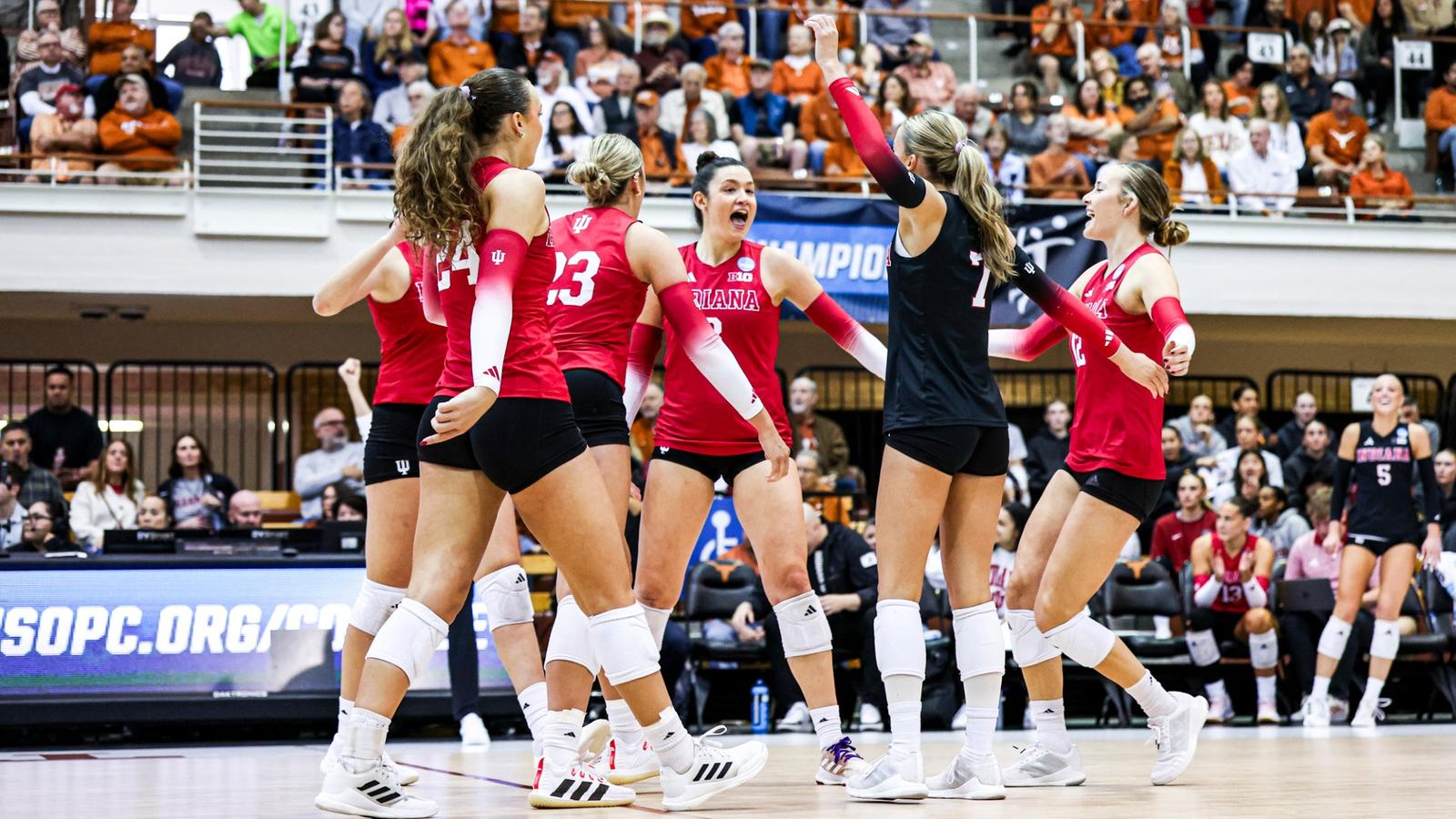
In one of the premier volleyball arenas in the country, the Hoosiers went blow-for-blow with the four-time national champions. IU lost by just a combined 11 points and reached the red zone (20+) in all three sets. Head coach Steve Aird‘s group recorded more kills (48-45) but couldn’t find a defensive answer for Texas’ All-American outside hitter Torrey Stafford.
Senior outside hitter Candela Alonso-Corcelles recorded 13 kills in her final game with the Hoosiers. It was the 74th time in her college tenure that she recorded a match with at least 10 kills. IU found great success in the middle with seven kills (.778) from senior middle blocker Madi Sell and eight kills (.700) from freshman middle blocker Victoria Gray.
Contributions from freshmen were felt from every part of the court. Freshman setter Teodora Krickovic dished out 38 assists while freshman outside hitter Jaidyn Jager contributed eight kills. Freshman outside hitter Charlotte Vinson had an ace and picked up her first career kill for the Hoosiers. Six of IU’s 10 players on the court were true freshmen on Friday.
In totality, IU’s 2025 team will go down as the greatest in program history. The Hoosiers broke single-season program records in the NCAA era for wins (25), regular season wins (23), Big Ten wins (14), road wins (9), ranked road wins (3). IU advanced to its second NCAA regional semifinal in school history.
How it Happened
• The defensive effort made the difference for Texas on Friday afternoon. The Longhorns racked up 10 more blocks than the Hoosiers (12.0-2.0). IU dug 38 balls but struggled to find points in transition. Texas had an answer for every IU swing in the match.
• Texas’ All-American outside hitter Torrey Stafford was virtually unstoppable on Friday. She picked up 19 kills on zero errors for a .679 hitting percentage. She dug eight balls and had a hand in four blocks as well. IU had more kills (48-46) but had 23 attacking errors.
Top Hoosier Performers
#3 Alonso-Corcelles, Candela
13 kills, 10 digs
#10 Krickovic, Teodora
38 assists, 7 digs, 2 kills
#23 Gray, Victoria
8 kills, .700 hitting percentage
Notes to Know
• Senior outside hitter Candela Alonso-Corcelles played her final career game for the Hoosiers. She provided 13 kills in the match, the 74th time that she’s had double-digit kills in a contest. She ends her career eighth in program history in kills (1,386). She’s the first IU player since Jordan Haverly (2009, 2010) with consecutive seasons of 400+ kills.
• The Hoosiers ended the 2025 season hitting .281 as a team. That is a new single-season program record, obliterating the previous IU standard (.246) from 1989. All three of IU’s pin hitters and all three middle blockers that played regular time finished with a hitting efficiency of .240 or better on the year.
• For players with at least 300 attempts in a season, freshman middle blocker Victoria Gray finished the season hitting .378 with 152 kills. That mark puts her second in a single season in program history while smashing the previous single-season freshman hitting percentage record.
• Senior opposite hitter Avry Tatum finished her IU career with a collective hitting percentage of .273 with 936 kills on more than 2,000 swings. Among all pin hitters in program history, no IU player hit at a better efficiency (min. 1,000 attempts) than Tatum did in her three seasons in Bloomington.
Sports
KU volleyball knocked out by unbeaten Nebraska in Sweet 16 sweep

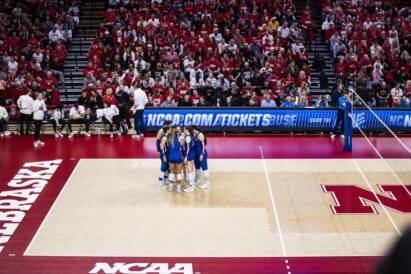
Kansas Athletics
The Kansas volleyball team huddles during its match against Nebraska on Friday, Dec. 12, 2025, in Lincoln, Neb.
A promising season of Kansas volleyball under the guidance of first-year head coach Matt Ulmer came to a grim end on Friday night in Lincoln, Nebraska, as the Jayhawks found themselves on the receiving end of a dominant 3-0 sweep (25-12, 25-11, 25-12) by the host Cornhuskers at the Bob Devaney Sports Center.
KU was overmatched in all phases against No. 1 overall seed Nebraska (33-0), which has still lost just one set at home all season and hit .450 against a usually rock-solid defense. The Jayhawks did not record a block until they trailed 20-10 in the final set, while senior libero Ryan White was limited to five digs in her final collegiate match.
Middle blocker Reese Ptacek, outside hitter Rhian Swanson and opposite hitter Jovana Zelenović accounted for six kills apiece, but they came on 15, 30 and 22 attacks, respectively. Katie Dalton recorded 11 assists, and Cristin Cline had eight.
Meanwhile, Nebraska’s Rebekah Allick recorded a kill all nine times she swung. The Cornhuskers’ setter Bergen Reilly, the Big Ten’s player and setter of the year, finished with 30 assists. Middle blocker Andi Jackson equaled Allick with nine more kills.
At the service line, the Jayhawks committed six errors with one ace.
“You’re really having to nitpick to try to figure out what to do to make (Nebraska) uncomfortable and you have to just execute at a much higher level than what we were able to do,” KU coach Matt Ulmer told reporters after the match. “We tried to serve some different spots, they held out pretty good. We tried to serve aggressive, but then you can’t miss too much. I just thought we had to be much cleaner from the service line to even apply some pressure.”
The Huskers didn’t let any of the three sets remain close for long, but they certainly opened the match with a bang as they came out with a 10-1 run capped off by consecutive aces by Olivia Mauch on reception errors by Logan Bell. The Jayhawks were able to get Zelenović going a bit with three kills late in the set, but the margin never got close, thanks in large part to Allick’s performance.
KU looked briefly like it might hang around longer in the second set when a kill by Dalton cut its deficit to 9-7. But Nebraska proceeded to score the next four times, while the Jayhawks only got four points the rest of the set.
The Huskers weren’t going to slip up and lose a set at home for the first time since Sept. 12. Instead, they strung together another 7-1 run early, featuring a couple of kills by Teraya Sigler, and never looked back.
The result brought a decisive end to the Jayhawks’ season in the Sweet 16, with one of their primary goals still accomplished as they had managed to make it out of the first weekend for the first time since 2021. They concluded the campaign with a record of 24-11 and a second-place finish in the Big 12 Conference.
“For us, as not good as right now feels, it’s been a great year for us and it’s been a great season and we’ve achieved so much, so I’m really proud of them,” Ulmer said. “I know it’s hard to feel that in the moment, but big picture, it was a great year for Kansas.”
The Jayhawks will have some holes to fill with six players having gone through senior day, including key contributors Dalton, Swanson and White. However, many of their top players were underclassmen, including a trio of international freshmen.
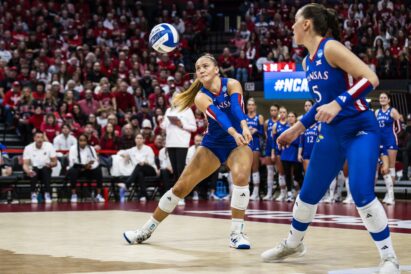 Kansas Athletics
Kansas AthleticsKansas pin hitter Grace Nelson makes a pass against Nebraska on Friday, Dec. 12, 2025, in Lincoln, Neb.
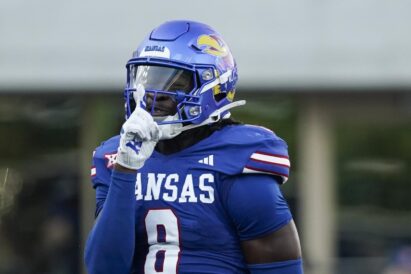
PREV POST
Jon Jon Kamara will transfer away from KU football
NEXT POST
KU volleyball knocked out by unbeaten Nebraska in Sweet 16 sweep

Sports
No. 1 Nebraska volleyball powers past Kansas, sets regional final date with Texas A&M

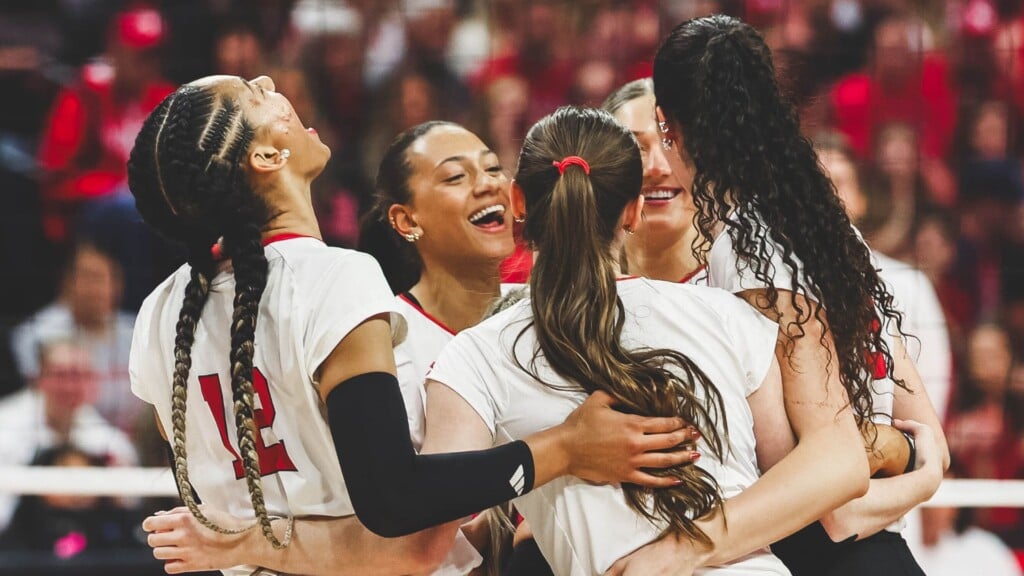
LINCOLN, Neb. (KLKN) — The No. 1-ranked Nebraska volleyball team took care of business Friday night, sweeping Kansas in the regional semifinal of the NCAA Tournament.
The Huskers won 25-12, 25-11, 25-12 at the Bob Devaney Center.
As a team, the Huskers boasted a .450% hitting percentage, compared to the Jayhawks’ .029%.
It was both middle blockers for Nebraska that paved the path to victory.
Rebekah Allick and Andi Jackson each had a team-high nine kills. Allick finished the match with a perfect 1.000% hitting percentage, and Jackson had a team-high five blocks.
Harper Murray followed close behind with seven kills and a .238% hitting percentage. She also tallied a team-high 10 digs.
Bergen Reilly led an efficient offense with 30 assists, and Olivia Mauch racked up three aces.
The Huskers will face off against Texas A&M on Sunday for a chance to go to the Final Four in Kansas City.
First serve is set for 2 p.m. on ABC.
Sports
Thirteen Student-Athletes Earn Degrees in Fall

Highlighting the 13 who graduated this fall were eight members of the K-State football team, and one each from the baseball, volleyball, rowing, soccer and women’s track and field programs.
The group of graduates was also honored Friday at the department’s annual graduation reception.
K-State continues to rank among the league’s best in terms of academic success as all programs are currently well above the required NCAA APR standard in addition to ranking among the best in the Big 12 in graduation rates – including five teams that have Big 12-leading marks this year.
2025 Fall Graduates
Baseball
Cadyn Karl, Finance
Football
JB Bradley, Integrative Human Sciences
Jet Dineen, Communications
Sam Hecht, Construction Science and Management
Damian Ilalio, Athletic Training and Rehab Sciences
Jacob Knuth, Management
Isaac Koch, Finance
Sterling Lockett, Management
Brayden Loftin, Kinesiology
Rowing
Emma Johnson (Jaelley), Elementary Education
Volleyball
Ava LeGrand, Finance
Soccer
Paige Dickson, Life Sciences
Women’s Track and Field
Brooklyn Jones, Integrative Human Sciences
Sports
When does Wisconsin volleyball play again? NCAA tournament next match
Dec. 12, 2025Updated Dec. 13, 2025, 12:33 a.m. CT
AUSTIN, Texas – Wisconsin volleyball will be spending two more days in Austin.
The Badgers ensured that with a four-set win over Stanford on Dec. 12 in the NCAA tournament regional semifinals. It was the eighth consecutive win in the regional semifinals for Kelly Sheffield’s group and its first-ever win over Stanford in program history.
Here’s what to know about Wisconsin’s next match:

Who will Wisconsin volleyball play next?
Wisconsin’s next match will be against top-seeded Texas in the NCAA tournament regional finals, with the winner advancing to the Final Four.
What time is Wisconsin volleyball’s next match?
The Wisconsin-Texas match will be on Sunday, Dec. 14 at 6:30 p.m. CT.
How to watch Wisconsin-Texas NCAA tournament regional finals match?

NCAA volleyball tournament bracket for regional finals
- Creighton vs. Kentucky on Dec. 13 at 5 p.m. in Lexington, Kentucky
- Purdue vs. Pittsburgh on Dec. 13 at 7:30 p.m. in Pittsburgh
- Wisconsin vs. Texas on Dec. 14 in Austin
- Winner of Nebraska/Kansas vs. winner of Louisville/Texas A&M on Dec. 14 in Lincoln, Nebraska
Sports
UAA signs trio of Alaska prep stars

ANCHORAGE (Dec. 12) – Riding the momentum from an outstanding 2025 season, the Alaska Anchorage volleyball team has begun reloading for future success with the signing of Alaska prep stars Indy Kmet, Vaiula Leaoa and Sophie Tapley, head coach Stacie Meisner announced Friday.
The newest Seawolves hail from all over the state and represent three of the four classifications in Alaska high school volleyball – 2A, 3A and 4A.
“We are fortunate to live in a state with great coaching at the developmental and high school levels, which has been proven by the contributions of high-level Alaskans who have come through our program,” said Meisner, whose team went 23-6 and tied for the Great Northwest Athletic Conference title this season. “We are thrilled that Indy, Ula and Sophie have decided to continue the tradition and welcome them to the Seawolf family.”
A 6-1 outside hitter, Kmet led South Anchorage to the Cook Inlet Conference regular-season title and an ASAA 4A State Tournament berth, along with earning MVP honors at the prestigious Dimond/Service tournament. She was also a key member of the 2024 South squad that finished state runner-up, making the ASAA All-Tournament Team as a junior.
Coach Meisner says…
“Indy is a strong athlete who we had the opportunity to work with at camp over the summer. She is incredibly coachable and a great all-around player with a lot of potential for continued improvement. She has impressive instincts on defense and puts up a big block in the front row. We are excited to see what she will bring to the table next fall to only increase the physicality of our roster.”
A 6-foot outside hitter, Leaoa finished a legendary career at Unalaska last month, leading the Raiders to a second consecutive 2A state title and a 39-match win streak to end her career. The Outstanding Hitter award-winner at this year’s state tournament, she ripped 19 kills in the title-match sweep of Su Valley.
Coach Meisner says…
“Ula is a really special player out of Dutch Harbor; it’s not often we see a player of her caliber coming from rural Alaska, and we are thrilled that she wanted to join our program. She is already very athletic and physical, with a big jump and a heavy arm swing. She also came to camp in July, so we got to work directly with her, and I believe her ceiling is going to be incredibly high.”
A 5-8 rightside hitter, Tapley led Kenai Central to its third 3A state championship in four seasons this year, earning Outstanding Hitter and All-Tournament honors. Tapley, who only started playing volleyball in seventh grade, was also an all-tournament selection at the 2024 state tournament.
Coach Meisner says…
“Sophie is a springy, left-handed attacker who sees the court well and plays an aggressive game. Her size is deceiving as she jumps incredibly well and has a very fast arm on her attack. We look forward to seeing how she will develop and continue to grow.”
The trio gives UAA five Alaskans on its 2026 roster, joining sophomore rightside hitter Emma Beck (Kenai) and sophomore libero/defensive specialist Eleasha Sapon (Anchorage/Dimond).
-

 Rec Sports3 weeks ago
Rec Sports3 weeks agoFirst Tee Winter Registration is open
-

 Rec Sports2 weeks ago
Rec Sports2 weeks agoFargo girl, 13, dies after collapsing during school basketball game – Grand Forks Herald
-

 Motorsports3 weeks ago
Motorsports3 weeks agoCPG Brands Like Allegra Are Betting on F1 for the First Time
-

 Motorsports3 weeks ago
Motorsports3 weeks agoF1 Las Vegas: Verstappen win, Norris and Piastri DQ tighten 2025 title fight
-

 Sports3 weeks ago
Sports3 weeks agoTwo Pro Volleyball Leagues Serve Up Plans for Minnesota Teams
-

 Sports3 weeks ago
Sports3 weeks agoSycamores unveil 2026 track and field schedule
-

 Sports3 weeks ago
Sports3 weeks agoUtah State Announces 2025-26 Indoor Track & Field Schedule
-

 Motorsports2 weeks ago
Motorsports2 weeks agoJo Shimoda Undergoes Back Surgery
-

 Motorsports2 weeks ago
Motorsports2 weeks agoRedemption Means First Pro Stock World Championship for Dallas Glenn
-

 Rec Sports2 weeks ago
Rec Sports2 weeks agoRobert “Bobby” Lewis Hardin, 56




























